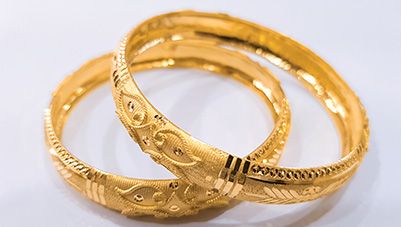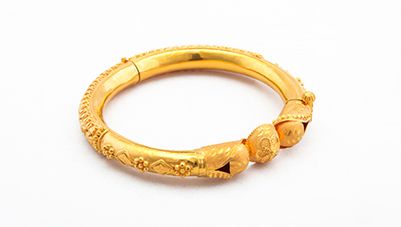Rs. 5,000 - Rs. 2 crore
To find the nearest gold loan branch,
Enter phone and OTP | Check amount you can get | Apply for quick funds
Best days to buy gold
Gold is treasured for its beauty, rarity, and cultural value, often seen as a symbol of prosperity. In India, people believe that certain days bring good luck for buying gold. Festivals like Akshaya Tritiya, Dhanteras, and Diwali are considered especially auspicious for gold purchases, believed to attract wealth and positivity. Apart from these occasions, it is also wise to buy gold during times of economic stability or when prices are lower, so you can get the best value for your money.
Step-by-step guide to calculating making charges
Calculating making charges for gold jewellery involves a few simple steps. Start by checking the current market price of gold per gram, as this is the base for your calculation. Then, find out the weight of the jewellery in grams. Multiply the weight by the market price to get the base value.
Next, add the making charge, which is the cost of crafting the piece. This can be a percentage of the base value or a fixed amount per gram. Multiply accordingly and then add the two values to get the total jewellery cost. Lastly, include any taxes or additional fees to find the final price you will pay.
Examples of making charges calculations
Let's consider two examples to illustrate the calculation of making charges for gold jewellery in the Indian context. Suppose the current market price of gold is ₹4,000 per gram. For a necklace weighing 20 grams with a making charge of 10%, the base value of the gold is ₹4,000 multiplied by 20, equalling ₹80,000. The making charge would be 10% of ₹80,000, which is ₹8,000. Therefore, the total cost of the necklace would be ₹88,000, excluding any taxes.
In another example, if a pair of earrings weighs 15 grams and the making charge is ₹500 per gram, the base value is ₹4,000 multiplied by 15, equalling ₹60,000. The making charge would be ₹500 multiplied by 15, which is ₹7,500. Thus, the total cost of the earrings would be ₹67,500, excluding any taxes. These examples highlight the different methods of calculating making charges, whether percentage-based or fixed per gram.
Tools and resources for calculating making charges
Various tools and resources are available to simplify the calculation of making charges for gold jewellery. Online calculators are widely used, allowing you to input the weight of the gold, the current market price, and the making charge percentage or fixed amount to quickly determine the total cost. Additionally, mobile apps specifically designed for jewellers offer comprehensive features, including real-time gold prices, making charge calculators, and tax inclusion options. Spreadsheets can also be an effective tool, enabling custom formulas to calculate costs accurately. Furthermore, jewellers often refer to industry-standard pricing guides and catalogues that provide benchmarks for making charges based on the type and complexity of the jewellery. These tools and resources ensure precision and efficiency in the calculation process, helping both jewellers and customers make informed decisions.
Tips for accurate calculation of making charges
Accuracy in calculating making charges is crucial for both jewellers and customers. Firstly, always verify the current market price of gold from a reliable source to ensure the base value is correct. Use precise weighing scales to measure the gold accurately, as even small discrepancies can significantly impact the final cost. When applying the making charge, be clear whether it is a percentage of the base value or a fixed amount per gram. Double-check your calculations to avoid errors and consider using digital tools or calculators for enhanced accuracy. Additionally, factor in any additional costs such as taxes, hallmarking charges, or other fees that may apply. Maintaining transparency throughout the calculation process builds trust with customers and ensures fair pricing. Regularly update your knowledge of industry standards and market trends to stay competitive and provide accurate quotations.
Factors affecting to calculate making charges on gold jewellery
Several factors influence the calculation of making charges on gold jewellery. The complexity and intricacy of the design play a significant role; more detailed and labour-intensive designs typically incur higher making charges. The type of craftsmanship required, such as handcrafting versus machine manufacturing, also affects the cost, with handcrafted items generally being more expensive. The purity of the gold is another factor; higher karat gold might have different making charges compared to lower karat gold due to variations in handling and processing.
Additionally, regional differences and the reputation of the jeweller can impact the making charges, as jewellers in different locations or those with a prestigious brand may charge more. Market conditions, such as fluctuations in gold prices and demand, can also affect the final calculation. Understanding these factors helps in providing accurate and fair pricing for gold jewellery.
Calculating loan amounts based on gold jewellery value
When seeking a loan against gold jewellery in India, understanding how to calculate the loan amount is crucial. The value of the gold jewellery is determined by its weight and the current market price of gold. Start by weighing the jewellery to find its weight in grams. Multiply this weight by the prevailing market price per gram to get the base value of the gold. Lenders typically offer a loan amount that is a percentage of this base value, known as the loan-to-value (LTV) ratio. For example, if the LTV ratio is 75% and the base value of the jewellery is ₹1,00,000, the loan amount would be ₹75,000. It's important to compare gold loan rates offered by different lenders, as these rates can vary. Understanding these calculations helps you estimate the loan amount you might be eligible for based on your gold jewellery's value.
Using calculated making charges for loan appraisals
In the context of loan appraisals for gold jewellery, accurately calculated making charges are essential. Lenders assess the total value of the jewellery, which includes both the base value of the gold and the making charges.
Start by calculating the base value of the gold, then add the making charges, which can be a percentage of the base value or a fixed amount per gram. This combined value gives the total worth of the jewellery, which is used to determine the loan amount. Ensuring that the making charges are correctly calculated and transparently documented can influence the appraisal process positively, leading to a more favourable loan offer.
Additionally, lenders may consider the overall quality and condition of the jewellery, so maintaining detailed records of the making charges and craftsmanship can support your application. Accurate appraisal ensures that you receive a fair loan amount based on the true value of your gold jewellery.
Have idle gold lying at home? Turn it into instant funds with a Bajaj Finserv Gold Loan today! Apply now
Related Articles
Disclaimer
Bajaj Finance Limited has the sole and absolute discretion, without assigning any reason to accept or reject any application. Terms and conditions apply*.









 Personal Loan
Personal Loan Check Eligibility
Check Eligibility Salaried Personal Loan
Salaried Personal Loan EMI Calculator
EMI Calculator Account Aggregator
Account Aggregator Credit Pulse Report
Credit Pulse Report
 Deals starting @99
Deals starting @99 Festive deals
Festive deals Min. 50% off
Min. 50% off
 Wallet to Bank
Wallet to Bank
 Easy EMI Loan
Easy EMI Loan Savings Offer
Savings Offer Smartphones
Smartphones Led TVs
Led TVs Washing Machines
Washing Machines Laptops
Laptops Refrigerators
Refrigerators Air Conditioner
Air Conditioner Air Coolers
Air Coolers
 Loan Against Shares
Loan Against Shares Loan Against Mutual Funds
Loan Against Mutual Funds Loan Against Insurance Policy
Loan Against Insurance Policy ESOP Financing
ESOP Financing Easy EMI Loan
Easy EMI Loan Two-wheeler Loan
Two-wheeler Loan Loan for Lawyer
Loan for Lawyer Industrial Equipment Finance
Industrial Equipment Finance Industrial Equipment Balance Transfer
Industrial Equipment Balance Transfer Industrial Equipment Refinance
Industrial Equipment Refinance Personal Loan Branch Locator
Personal Loan Branch Locator Used Tractor Loan
Used Tractor Loan Loan Against Tractor
Loan Against Tractor Tractor Loan Balance Transfer
Tractor Loan Balance Transfer
 Two-wheeler Loan
Two-wheeler Loan Bike
Bike Scooter
Scooter Electric Vehicle
Electric Vehicle Best Sellers
Best Sellers Popular Brands
Popular Brands

 Trading Account
Trading Account Open Demat Account
Open Demat Account Margin Trading Financing
Margin Trading Financing Share Market
Share Market Invest in IPO
Invest in IPO All stocks
All stocks Top gainers
Top gainers Top losers
Top losers 52 week high
52 week high 52 week low
52 week low Loan against shares
Loan against shares
 Home Loan
Home Loan Transfer your existing Home loan
Transfer your existing Home loan Loan against Property
Loan against Property Home Loan for Salaried
Home Loan for Salaried Home loan for self employed
Home loan for self employed Home Loan EMI Calculator
Home Loan EMI Calculator Home Loan eligibility calculator
Home Loan eligibility calculator Home Loan balance transfer
Home Loan balance transfer
 Term Life Insurance
Term Life Insurance ULIP Plan
ULIP Plan Savings Plan
Savings Plan Family Insurance
Family Insurance Senior Citizen Health Insurance
Senior Citizen Health Insurance Critical Illness Insurance
Critical Illness Insurance Child Health Insurance
Child Health Insurance Pregnancy and Maternity Health Insurance
Pregnancy and Maternity Health Insurance Individual Health Insurance
Individual Health Insurance Low Income Health Insurance
Low Income Health Insurance Student Health Insurance
Student Health Insurance Group Health Insurance
Group Health Insurance Retirement Plans
Retirement Plans Child Plans
Child Plans Investment Plans
Investment Plans
 Business Loan
Business Loan Secured Business Loan
Secured Business Loan Loan against property
Loan against property Loans against property balance transfer
Loans against property balance transfer Loan against shares
Loan against shares Home Loan
Home Loan Loans against mutual funds
Loans against mutual funds Loan against bonds
Loan against bonds Loan against insurance policy
Loan against insurance policy
 Apply for Gold Loan
Apply for Gold Loan Transfer your Gold Loan with Us
Transfer your Gold Loan with Us Gold Loan Branch Locator
Gold Loan Branch Locator
 ULIP Plan
ULIP Plan Savings Plan
Savings Plan Retirement Plans
Retirement Plans Child Plans
Child Plans Free Demat Account
Free Demat Account Invest in Stocks
Invest in Stocks Invest in IPO
Invest in IPO Margin Trading Facility
Margin Trading Facility Fixed Deposit Branch Locator
Fixed Deposit Branch Locator
 Check your Credit Score
Check your Credit Score
 New Car Loan
New Car Loan Used Car Loan
Used Car Loan Loan Against Car
Loan Against Car Car Loan Balance Transfer and Top-up
Car Loan Balance Transfer and Top-up
 Get Bajaj Prime
Get Bajaj Prime
 Mobiles on EMI
Mobiles on EMI Electronics on EMI Offer
Electronics on EMI Offer  Iphone on EMI
Iphone on EMI LED TV on EMI
LED TV on EMI Refrigerator on EMI
Refrigerator on EMI Laptop on EMI
Laptop on EMI Kitchen appliances on EMI
Kitchen appliances on EMI Washing machines
Washing machines
 Personal Loan EMI Calculator
Personal Loan EMI Calculator Personal Loan Eligibility Calculator
Personal Loan Eligibility Calculator Home Loan EMI Calculator
Home Loan EMI Calculator Home Loan Eligibility Calculator
Home Loan Eligibility Calculator Good & Service Tax (GST) Calculator
Good & Service Tax (GST) Calculator Flexi Day Wise Interest Calculator
Flexi Day Wise Interest Calculator Flexi Transaction Calculator
Flexi Transaction Calculator Secured Business Loan Eligibility Calculator
Secured Business Loan Eligibility Calculator Fixed Deposits Interest Calculator
Fixed Deposits Interest Calculator Two wheeler Loan EMI Calculator
Two wheeler Loan EMI Calculator New Car Loan EMI Calculator
New Car Loan EMI Calculator Used Car Loan EMI Calculator
Used Car Loan EMI Calculator All Calculator
All Calculator Used Tractor Loan EMI Calculator
Used Tractor Loan EMI Calculator
 Hot Deals
Hot Deals Clearance Sale
Clearance Sale Kitchen Appliances
Kitchen Appliances Tyres
Tyres Camera & Accessories
Camera & Accessories Mattresses
Mattresses Furniture
Furniture Watches
Watches Music & Audio
Music & Audio Cycles
Cycles Mixer & Grinder
Mixer & Grinder Luggage & Travel
Luggage & Travel Fitness Equipment
Fitness Equipment Fans
Fans
 Personal Loan for Doctors
Personal Loan for Doctors Business loan for Doctors
Business loan for Doctors Medical Equipment Finance
Medical Equipment Finance Secured Business Loan
Secured Business Loan Loan against property
Loan against property Secured Business Loan Balance Transfer
Secured Business Loan Balance Transfer Loan against share
Loan against share Gold Loan
Gold Loan Home Loan
Home Loan
 Engagement Zone
Engagement Zone Game Zone
Game Zone
 Savings Offer
Savings Offer Easy EMI
Easy EMI Offer World
Offer World 1 EMI OFF
1 EMI OFF New Launches
New Launches Zero Down Payment
Zero Down Payment Clearance Sale
Clearance Sale Bajaj Mall Sale
Bajaj Mall Sale
 Mobiles under ₹20,000
Mobiles under ₹20,000 Mobiles under ₹25,000
Mobiles under ₹25,000 Mobiles under ₹30,000
Mobiles under ₹30,000 Mobiles under ₹35,000
Mobiles under ₹35,000 Mobiles under ₹40,000
Mobiles under ₹40,000 Mobiles under ₹50,000
Mobiles under ₹50,000
 Articles
Articles
 Overdue Payments
Overdue Payments Other Payments
Other Payments
 Document Center
Document Center Bank details & Documents
Bank details & Documents Tax Invoice Certificate
Tax Invoice Certificate
 Do Not Call Service
Do Not Call Service
 Hamara Mall Orders
Hamara Mall Orders

 Check Loan Offer
Check Loan Offer Mobiles on EMI
Mobiles on EMI Trade directly with your Demat A/c
Trade directly with your Demat A/c ITR
ITR My Garage
My Garage
 Live Videos - Beta
Live Videos - Beta
 Savings Offer
Savings Offer Smartphones
Smartphones LED TVs
LED TVs Washing Machines
Washing Machines Laptops
Laptops Refrigerators
Refrigerators Air Conditioners
Air Conditioners Air Coolers
Air Coolers Water Purifiers
Water Purifiers Tablets
Tablets Kitchen Appliances
Kitchen Appliances Mattresses
Mattresses Furniture
Furniture Music and Audio
Music and Audio Cameras & Accessories
Cameras & Accessories Cycle
Cycle Watches
Watches Tyres
Tyres Luggage & Travel
Luggage & Travel Fitness Equipment
Fitness Equipment Tractor
Tractor Easy EMI Loan
Easy EMI Loan
 vivo Mobiles
vivo Mobiles OPPO Mobiles
OPPO Mobiles Xiaomi Mobiles
Xiaomi Mobiles Sony LED TVs
Sony LED TVs Samsung LED TVs
Samsung LED TVs LG LED TVs
LG LED TVs Haier LED TVs
Haier LED TVs Godrej Refrigerators
Godrej Refrigerators Voltas Washing Machines
Voltas Washing Machines









